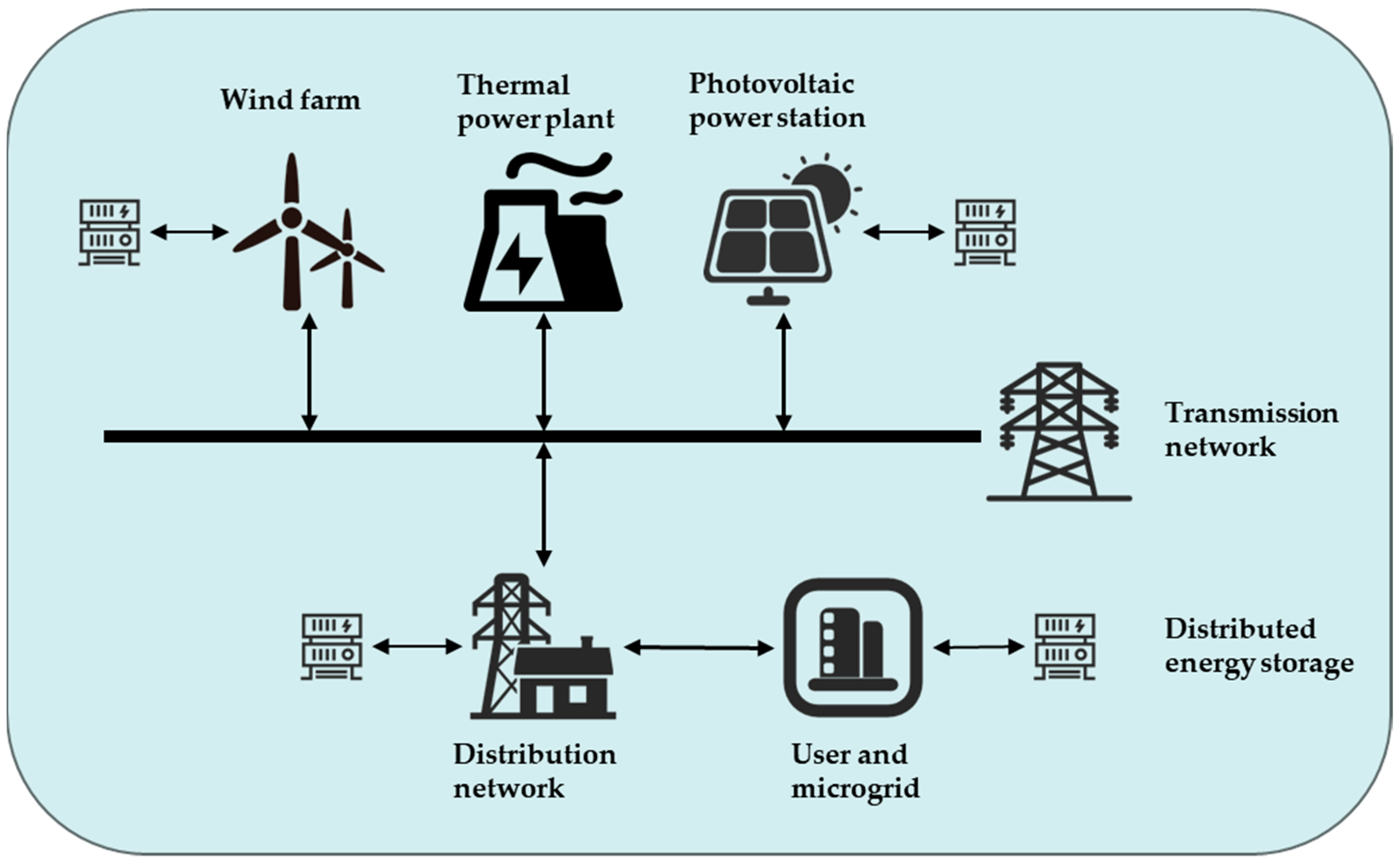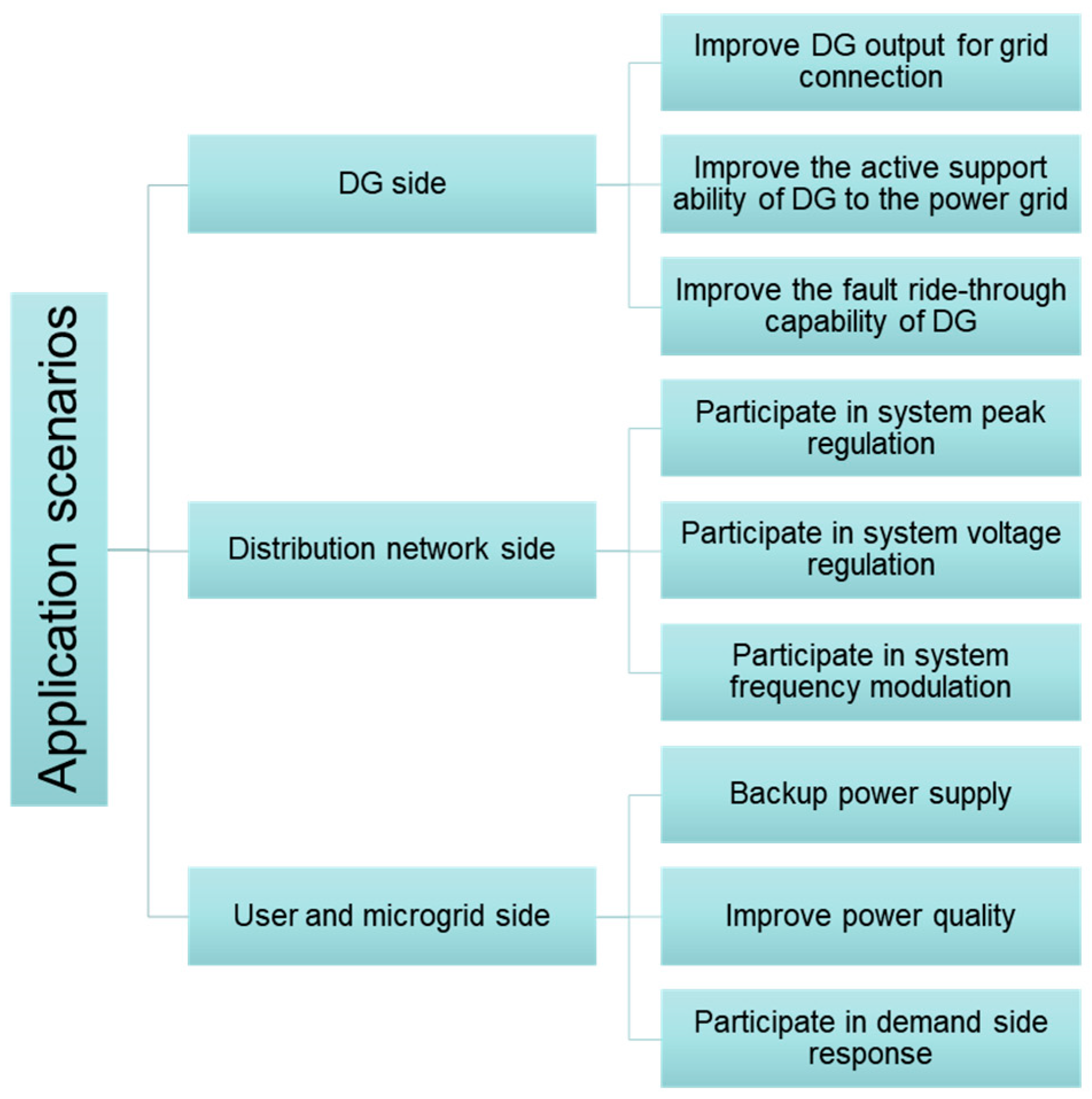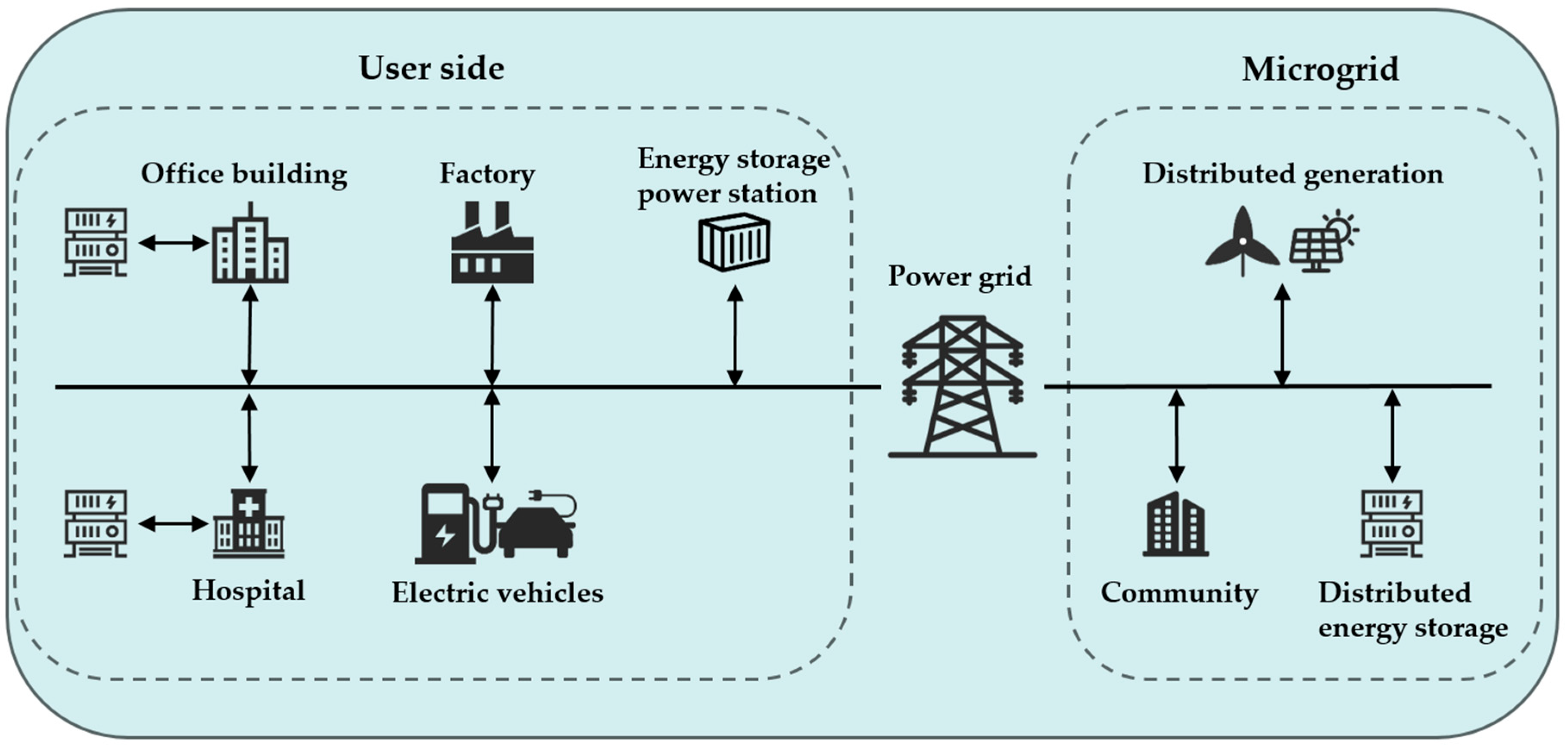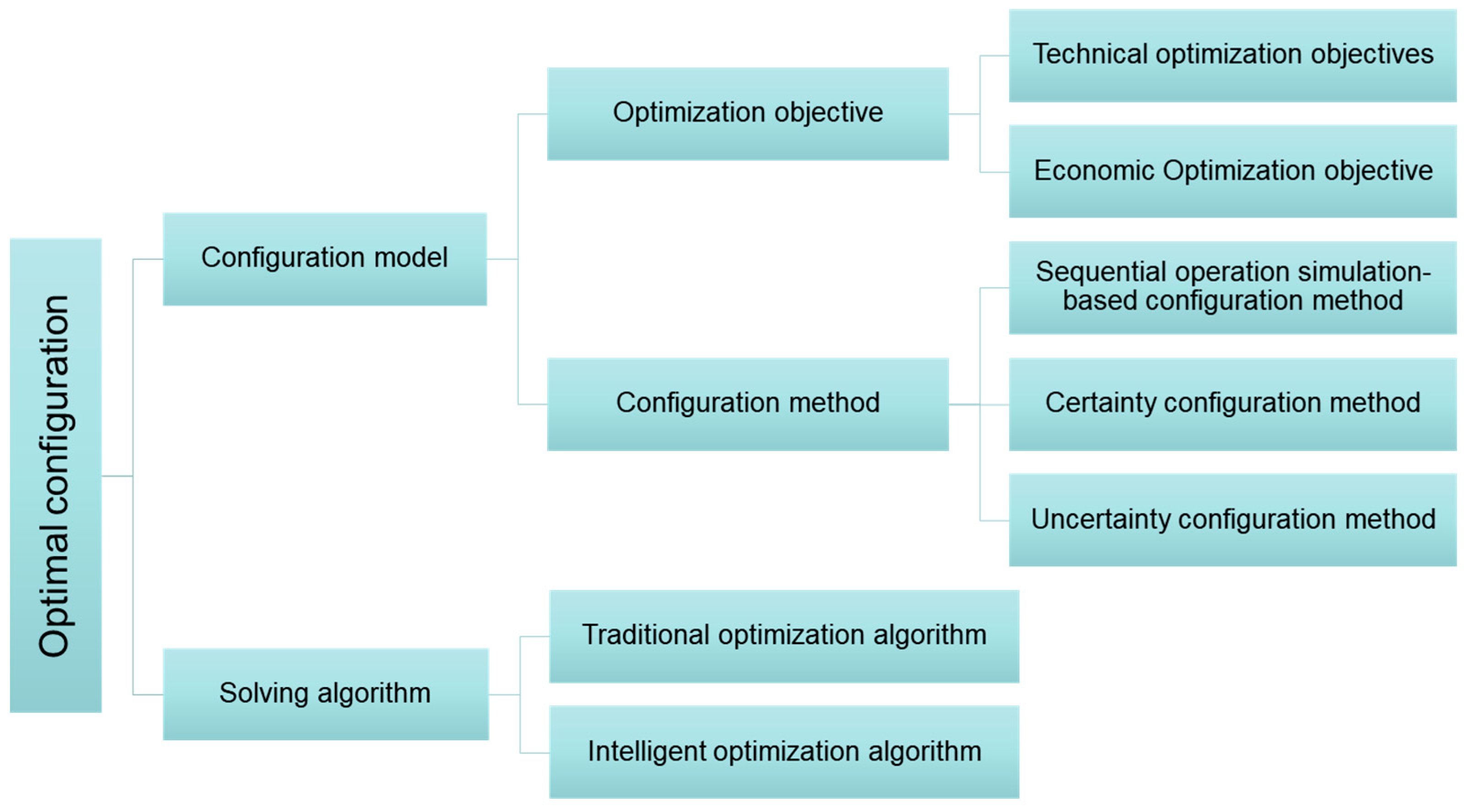Review on the Optimal Configuration of Distributed Energy Storage
Abstract
1. Introduction
2. Application Status of Distributed Energy Storage
2.1. DG Side
2.1.1. Improve DG Output for Grid Connection
2.1.2. Improve the Active Support Ability of DG for a Power Grid
2.1.3. Improve the Fault Ride-through Capability of DG
2.2. Grid Side
2.2.1. Participate in System Peak Regulation
2.2.2. Participate in System Voltage Regulation
2.2.3. Participate in System Frequency Modulation
2.3. User and Microgrid Side
2.3.1. Backup Power Supply
2.3.2. Improve Power Quality
2.3.3. Participate in the Demand-Side Response
3. Optimal Configuration of Distributed Energy Storage
3.1. Configuration Model
3.1.1. Optimization Objective
3.1.2. Configuration Method
3.2. Solving Algorithm
4. Conclusions
Author Contributions
Funding
Data Availability Statement
Conflicts of Interest
Nomenclature
| DG | Distributed generation | LVRT | Low voltage ride-through |
| PV | Photovoltaic | AGC | Automatic generation control |
| SCES | Supercapacitor energy storage | SOC | State of Charge |
| SMES | Superconducting magnetic energy storage | GA | Genetic algorithm |
| AC | Alternating Current | PSO | Particle swarm optimization algorithm |
| DC | Direct Current | SA | simulated annealing algorithm |
References
- Tan, K.M.; Babu, T.S.; Ramachandaramurthy, V.K.; Kasinathan, P.; Solanki, S.G.; Raveendran, S.K. Empowering smart grid: A comprehensive review of energy storage technology and application with renewable energy integration. J. Energy Storage 2021, 39, 102591. [Google Scholar] [CrossRef]
- Mohandes, B.; El Moursi, M.S.; Hatziargyriou, N.D.; El Khatib, S. A Review of Power System Flexibility with High Penetration of Renewables. IEEE Trans. Power Syst. 2019, 34, 3140–3155. [Google Scholar] [CrossRef]
- Sinsel, S.R.; Riemke, R.L.; Hoffmann, V.H. Challenges and solution technologies for the integration of variable renewable energy sources—A review. Renew. Energy 2020, 145, 2271–2285. [Google Scholar] [CrossRef]
- Chen, X.; Mcelroy, M.B.; Wu, Q.; Shu, Y.; Xue, Y. Transition towards higher penetration of renewables: An overview of inter-linked technical, environmental and socio-economic challenges. J. Mod. Power Syst. Clean Energy 2019, 7, 1–8. [Google Scholar] [CrossRef]
- Sewnet, A.; Khan, B.; Gidey, I.; Mahela, O.P.; El-Shahat, A.; Abdelaziz, A.Y. Mitigating Generation Schedule Deviation of Wind Farm Using Battery Energy Storage System. Energies 2022, 15, 1768. [Google Scholar] [CrossRef]
- Sun, Y.; Zhao, Z.; Yang, M.; Jia, D.; Pei, W.; Xu, B. Overview of energy storage in renewable energy power fluctuation mitigation. CSEE J. Power Energy Syst. 2019, 6, 160–173. [Google Scholar]
- Akrami, A.; Doostizadeh, M.; Aminifar, F. Power system flexibility: An overview of emergence to evolution. J. Mod. Power Syst. Clean Energy 2019, 7, 987–1007. [Google Scholar] [CrossRef]
- Rajagopalan, A.; Swaminathan, D.; Alharbi, M.; Sengan, S.; Montoya, O.D.; El-Shafai, W.; Fouda, M.M.; Aly, M.H. Modernized Planning of Smart Grid Based on Distributed Power Generations and Energy Storage Systems Using Soft Computing Methods. Energies 2022, 15, 8889. [Google Scholar] [CrossRef]
- Choudhury, S. Review of energy storage system technologies integration to microgrid: Types, control strategies, issues, and future prospects. J. Energy Storage 2022, 48, 103966. [Google Scholar] [CrossRef]
- Sufyan, M.; Rahim, N.A.; Aman, M.M.; Tan, C.K.; Raihan, S.R.S. Sizing and applications of battery energy storage technologies in smart grid system: A review. J. Renew. Sustain. Energy 2019, 11, 14105. [Google Scholar] [CrossRef]
- Sayed, E.T.; Olabi, A.G.; Alami, A.H.; Radwan, A.; Mdallal, A.; Rezk, A.; Abdelkareem, M.A. Renewable Energy and Energy Storage Systems. Energies 2023, 16, 1415. [Google Scholar] [CrossRef]
- Lehtola, T.; Zahedi, A. Solar energy and wind power supply supported by storage technology: A review. Sustain. Energy Technol. Assessments 2019, 35, 25–31. [Google Scholar] [CrossRef]
- Argyrou, M.C.; Christodoulides, P.; Kalogirou, S.A. Energy storage for electricity generation and related processes: Technologies appraisal and grid scale applications. Renew. Sustain. Energy Rev. 2018, 94, 804–821. [Google Scholar] [CrossRef]
- Agajie, T.F.; Ali, A.; Fopah-Lele, A.; Amoussou, I.; Khan, B.; Velasco, C.L.R.; Tanyi, E. A Comprehensive Review on Tech-no-Economic Analysis and Optimal Sizing of Hybrid Renewable Energy Sources with Energy Storage Systems. Energies 2023, 16, 642. [Google Scholar]
- Davies, D.; Verde, M.; Mnyshenko, O.; Chen, Y.; Rajeev, R.; Meng, Y.; Elliott, G. Combined economic and technological eval-uation of battery energy storage for grid applications. Nat. Energy 2019, 4, 42–50. [Google Scholar] [CrossRef]
- Das, C.K.; Bass, O.; Mahmoud, T.S.; Kothapalli, G.; Masoum, M.A.; Mousavi, N. An optimal allocation and sizing strategy of distributed energy storage systems to improve performance of distribution networks. J. Energy Storage 2019, 26, 100847. [Google Scholar] [CrossRef]
- Olabi, A.; Onumaegbu, C.; Wilberforce, T.; Ramadan, M.; Abdelkareem, M.A.; Alami, A.H.A. Critical review of energy storage systems. Energy 2020, 214, 118987. [Google Scholar] [CrossRef]
- AL Shaqsi, A.Z.; Sopian, K.; Al-Hinai, A. Review of energy storage services, applications, limitations, and benefits. Energy Rep. 2020, 6, 288–306. [Google Scholar] [CrossRef]
- Calero, F.; Cañizares, C.A.; Bhattacharya, K.; Anierobi, C.; Calero, I.; de Souza, M.F.Z.; Farrokhabadi, M.; Guzman, N.S.; Mendieta, W.; Peralta, D.; et al. A Review of Modeling and Applications of Energy Storage Systems in Power Grids. Proc. IEEE 2022, 111, 806–831. [Google Scholar] [CrossRef]
- Sikorski, T.; Jasiński, M.; Ropuszyńska-Surma, E.; Węglarz, M.; Kaczorowska, D.; Kostyla, P.; Leonowicz, Z.; Lis, R.; Rezmer, J.; Rojewski, W. A case study on distributed energy resources and energy-storage systems in a virtual power plant concept: Technical aspects. Energies 2020, 13, 3086. [Google Scholar] [CrossRef]
- Zhang, Z.; Ding, T.; Zhou, Q.; Sun, Y.; Qu, M.; Zeng, Z.; Ju, Y.; Li, L.; Wang, K.; Chi, F. A review of technologies and applications on versatile energy storage systems. Renew. Sustain. Energy Rev. 2021, 148, 111263. [Google Scholar] [CrossRef]
- Photovoltaics, D.G.; Storage, E. IEEE standard for interconnection and interoperability of distributed energy resources with associated electric power systems interfaces. IEEE Std. 2018, 1547, 1547–2018. [Google Scholar]
- Vartanian, C.; Bauer, R.; Casey, L.; Loutan, C.; Narang, D.; Patel, V. Ensuring System Reliability: Distributed Energy Resources and Bulk Power System Considerations. IEEE Power Energy Mag. 2018, 16, 52–63. [Google Scholar] [CrossRef]
- Stenclik, D.; Denholm, P.; Chalamala, B. Maintaining Balance: The Increasing Role of Energy Storage for Renewable Integration. IEEE Power Energy Mag. 2017, 15, 31–39. [Google Scholar] [CrossRef]
- Oh, E.; Son, S.-Y. Energy-storage system sizing and operation strategies based on discrete Fourier transform for reliable wind-power generation. Renew. Energy 2018, 116, 786–794. [Google Scholar] [CrossRef]
- Atif, A.; Khalid, M. Fuzzy logic controller for solar power smoothing based on controlled battery energy storage and varying low pass filter. IET Renew. Power Gener. 2020, 14, 3824–3833. [Google Scholar] [CrossRef]
- Lamsal, D.; Sreeram, V.; Mishra, Y.; Kumar, D. Smoothing control strategy of wind and photovoltaic output power fluctuation by considering the state of health of battery energy storage system. IET Renew. Power Gener. 2019, 13, 578–586. [Google Scholar] [CrossRef]
- Bullich-Massagué, E.; Cifuentes-García, F.-J.; Glenny-Crende, I.; Cheah-Mañé, M.; Aragüés-Peñalba, M.; Díaz-González, F.; Gomis-Bellmunt, O. A review of energy storage technologies for large scale photovoltaic power plants. Appl. Energy 2020, 274, 115213. [Google Scholar] [CrossRef]
- Jiang, X.; Nan, G.; Liu, H.; Guo, Z.; Zeng, Q.; Jin, Y. Optimization of Battery Energy Storage System Capacity for Wind Farm with Considering Auxiliary Services Compensation. Appl. Sci. 2018, 8, 1957. [Google Scholar] [CrossRef]
- Kodaira, D.; Jung, W.; Han, S. Optimal Energy Storage System Operation for Peak Reduction in a Distribution Network Using a Prediction Interval. IEEE Trans. Smart Grid 2019, 11, 2208–2217. [Google Scholar] [CrossRef]
- Sedighizadeh, M.; Esmaili, M.; Jamshidi, A.; Ghaderi, M.-H. Stochastic multi-objective economic-environmental energy and reserve scheduling of microgrids considering battery energy storage system. Int. J. Electr. Power Energy Syst. 2019, 106, 1–16. [Google Scholar] [CrossRef]
- Oskouei, M.Z.; Mohammadi-Ivatloo, B.; Erdinc, O.; Erdinc, F.G. Optimal Allocation of Renewable Sources and Energy Storage Systems in Partitioned Power Networks to Create Supply-Sufficient Areas. IEEE Trans. Sustain. Energy 2020, 12, 999–1008. [Google Scholar] [CrossRef]
- Moghaddam, I.N.; Chowdhury, B.H.; Mohajeryami, S. Predictive Operation and Optimal Sizing of Battery Energy Storage with High Wind Energy Penetration. IEEE Trans. Ind. Electron. 2017, 65, 6686–6695. [Google Scholar] [CrossRef]
- Li, J.; Zhang, Z.; Shen, B.; Gao, Z.; Ma, D.; Yue, P.; Pan, J. The capacity allocation method of photovoltaic and energy storage hybrid system considering the whole life cycle. J. Clean. Prod. 2020, 275, 122902. [Google Scholar] [CrossRef]
- Hu, X.; Deng, X.; Wang, F.; Deng, Z.; Lin, X.; Teodorescu, R.; Pecht, M.G. A Review of Second-Life Lithium-Ion Batteries for Stationary Energy Storage Applications. Proc. IEEE. 2022, 110, 735–753. [Google Scholar] [CrossRef]
- Citroni, R.; Di Paolo, F.; Livreri, P. Evaluation of an optical energy harvester for SHM applications. AEU Int. J. Electron. Commun. 2019, 111, 152918. [Google Scholar]
- Hossain, E.; Faruque, H.M.R.; Sunny, M.S.H.; Mohammad, N.; Nawar, N. A Comprehensive Review on Energy Storage Systems: Types, Comparison, Current Scenario, Applications, Barriers, and Potential Solutions, Policies, and Future Prospects. Energies 2020, 13, 3651. [Google Scholar] [CrossRef]
- Rahman, M.; Oni, A.O.; Gemechu, E.; Kumar, A. Assessment of energy storage technologies: A review. Energy Convers. Manag. 2020, 223, 113295. [Google Scholar] [CrossRef]
- Ju, C.; Wang, P.; Goel, L.; Xu, Y. A Two-Layer Energy Management System for Microgrids with Hybrid Energy Storage Considering Degradation Costs. IEEE Trans. Smart Grid 2017, 9, 6047–6057. [Google Scholar] [CrossRef]
- Zhang, W.; Maleki, A.; Rosen, M.A.; Liu, J. Optimization with a simulated annealing algorithm of a hybrid system for renewable energy including battery and hydrogen storage. Energy 2018, 163, 191–207. [Google Scholar] [CrossRef]
- Babu, T.S.; Vasudevan, K.R.; Ramachandaramurthy, V.K.; Sani, S.B.; Chemud, S.; Lajim, R.M. A Comprehensive Review of Hybrid Energy Storage Systems: Converter Topologies, Control Strategies and Future Prospects. IEEE Access 2020, 8, 148702–148721. [Google Scholar] [CrossRef]
- Li, X.; Ma, R.; Yan, N.; Wang, S.; Hui, D. Research on Optimal Scheduling Method of Hybrid Energy Storage System Considering Health State of Echelon-Use Lithium-Ion Battery. IEEE Trans. Appl. Supercond. 2021, 31, 604204. [Google Scholar] [CrossRef]
- Parks, K. Declining Capacity Credit for Energy Storage and Demand Response with Increased Penetration. IEEE Trans. Power Syst. 2019, 34, 4542–4546. [Google Scholar] [CrossRef]
- Byers, C.; Botterud, A. Additional Capacity Value from Synergy of Variable Renewable Energy and Energy Storage. IEEE Trans. Sustain. Energy 2019, 11, 1106–1109. [Google Scholar] [CrossRef]
- Mills, A.D.; Rodriguez, P. A simple and fast algorithm for estimating the capacity credit of solar and storage. Energy 2020, 210, 118587. [Google Scholar] [CrossRef]
- Li, Y.; Zhang, X.; Gao, W.; Ruan, Y. Capacity credit and market value analysis of photovoltaic integration considering grid flexibility requirements. Renew. Energy 2020, 159, 908–919. [Google Scholar] [CrossRef]
- Cai, J.; Xu, Q. Capacity credit evaluation of wind energy using a robust secant method incorporating improved importance sampling. Sustain. Energy Technol. Assess. 2021, 43, 100892. [Google Scholar] [CrossRef]
- Beltran, H.; Harrison, S.; Egea-Àlvarez, A.; Xu, L. Techno-economic assessment of energy storage technologies for inertia re-sponse and frequency support from wind farms. Energies 2020, 13, 3421. [Google Scholar] [CrossRef]
- Golpira, H.; Atarodi, A.; Amini, S.; Messina, A.R.; Francois, B.; Bevrani, H. Optimal Energy Storage System-Based Virtual Inertia Placement: A Frequency Stability Point of View. IEEE Trans. Power Syst. 2020, 35, 4824–4835. [Google Scholar] [CrossRef]
- Shazon, N.H.; Masood, N.A.; Ahmed, H.M.; Deeba, S.R.; Hossain, E. Exploring the Utilization of Energy Storage Systems for Frequency Response Adequacy of a Low Inertia Power Grid. IEEE Access 2021, 9, 129933–129950. [Google Scholar] [CrossRef]
- Zhang, X.; Ding, T.; Mu, C.; Han, O.; Huang, Y.; Shahidehpour, M. Dual Stochastic Dual Dynamic Programming for Mul-ti-Stage Economic Dispatch with Renewable Energy and Thermal Energy Storage. IEEE Trans. Power Syst. Early Access 2023, 1–12. [Google Scholar] [CrossRef]
- Saxena, P.; Singh, N.K.; Pandey, A.K. Enhancing the dynamic performance of microgrid using derivative controlled solar and energy storage based virtual inertia system. J. Energy Storage 2020, 31, 101613. [Google Scholar] [CrossRef]
- Bagaber, B.; Mertens, A. Fault Ride-Through Performance of Pumping Cycle Airborne Wind Energy Generators with the Support of Optimally Sized Energy Storage System. In Proceedings of the 2021 IEEE 12th Energy Conversion Congress & Exposition—Asia (ECCE-Asia), Singapore, 24–27 May 2021; pp. 1144–1150. [Google Scholar] [CrossRef]
- Manikanta, B.; Kesavarao, G.; Talati, S. LVRT of grid connected PV system with energy storage. Int. J. Control Theory Appl. 2017, 10, 75–86. [Google Scholar]
- Chen, L.; Chen, H.; Li, Y.; Li, G.; Yang, J.; Liu, X.; Xu, Y.; Ren, L.; Tang, Y. SMES-Battery Energy Storage System for the Stabilization of a Photovoltaic-Based Microgrid. IEEE Trans. Appl. Supercond. 2018, 28, 5700407. [Google Scholar] [CrossRef]
- Guo, S.; Kurban, A.; He, Y.; Wu, F.; Pei, H.; Song, G. Multi-objective sizing of solar-wind-hydro hybrid power system with doubled energy storages under optimal coordinated operation strategy. CSEE J. Power Energy Syst. 2021, 1–11. [Google Scholar] [CrossRef]
- Tait, J.; Wang, S.; Ahmed, K.; Adam, G.P. Comparative assessment of four low voltage fault ride through techniques (LVFRT) for wind energy conversion systems (WECSs). Alex. Eng. J. 2022, 61, 10463–10476. [Google Scholar] [CrossRef]
- Yang, Y.; Yan, G.; Mu, G. Integrated Heating Load and Storage Control for Curtailed Wind Power Consumption in China’s Power Market. J. Energy Eng. 2017, 143, 5. [Google Scholar] [CrossRef]
- Yang, L.; Zhang, L.; Wang, Y.; Huo, W.; Wang, D. Integrated energy scheduling using wind-storage cascade control strategy in dynamic peak regulation right. Electr. Power Syst. Res. 2022, 212, 108644. [Google Scholar] [CrossRef]
- Guo, H.; Wang, Y.; Liu, S.; Tang, L.; Li, L.; Mei, S. Research on Capacity Allocation of Grid Side Energy Storage Participating in Power System Peak Shaving. In Proceedings of the 2022 7th International Conference on Power and Renewable Energy (ICPRE), Shanghai, China, 23–26 September 2022; pp. 1164–1169. [Google Scholar] [CrossRef]
- Martins, R.; Hesse, H.C.; Jungbauer, J.; Vorbuchner, T.; Musilek, P. Optimal Component Sizing for Peak Shaving in Battery Energy Storage System for Industrial Applications. Energies 2018, 11, 2048. [Google Scholar] [CrossRef]
- Wang, S.; Li, F.; Zhang, G.; Yin, C. Analysis of energy storage demand for peak shaving and frequency regulation of power systems with high penetration of renewable energy. Energy 2023, 267, 126586. [Google Scholar] [CrossRef]
- Chen, L.; Cui, H.; Cui, G.; Yang, B.; Yang, M.; Liu, H. Voltage optimization Strategy of Distribution Network Considering the Reactive Power of Energy Storage. In Proceedings of the 2020 12th IEEE PES Asia-Pacific Power and Energy Engineering Conference (APPEEC), Nanjing, China, 20–23 September 2020; pp. 1–5. [Google Scholar] [CrossRef]
- Li, Y.; He, L.; Liu, F.; Li, C.; Cao, Y.; Shahidehpour, M. Flexible Voltage Control Strategy Considering Distributed Energy Storages for DC Distribution Network. IEEE Trans. Smart Grid 2017, 10, 163–172. [Google Scholar] [CrossRef]
- Yu, P.; Wan, C.; Song, Y.; Jiang, Y. Distributed Control of Multi-Energy Storage Systems for Voltage Regulation in Distribution Networks: A Back-and-Forth Communication Framework. IEEE Trans. Smart Grid 2020, 12, 1964–1977. [Google Scholar] [CrossRef]
- Zhang, D.; Li, J.; Hui, D. Coordinated control for voltage regulation of distribution network voltage regulation by distributed energy storage systems. Prot. Control Mod. Power Syst. 2018, 3, 3. [Google Scholar] [CrossRef]
- Zhao, T.; Parisio, A.; Milanović, J.V. Distributed control of battery energy storage systems in distribution networks for voltage regulation at transmission–distribution network interconnection points. Control Eng. Pr. 2021, 119, 104988. [Google Scholar] [CrossRef]
- Meng, G.; Chang, Q.; Sun, Y.; Rao, Y.; Zhang, F.; Wu, Y.; Su, L. Energy Storage Auxiliary Frequency Modulation Control Strategy Considering ACE and SOC of Energy Storage. IEEE Access 2021, 9, 26271–26277. [Google Scholar] [CrossRef]
- Meng, L.; Zafar, J.; Khadem, S.K.; Collinson, A.; Murchie, K.C.; Coffele, F.; Burt, G.M. Fast frequency response from energy storage systems—A review of grid standards, projects and technical issues. IEEE Trans. Smart Grid 2019, 11, 1566–1581. [Google Scholar] [CrossRef]
- Chen, W.; Liu, B.; Nazir, M.S.; Abdalla, A.N.; Mohamed, M.A.; Ding, Z.; Bhutta, M.S.; Gul, M. An Energy Storage Assessment: Using Frequency Modulation Approach to Capture Optimal Coordination. Sustainability 2022, 14, 8510. [Google Scholar] [CrossRef]
- Ramirez-Gonzalez, M.; Castellanos, R.; Calderón, G.; Malik, O. Placement and sizing of battery energy storage for primary frequency control in an isolated section of the Mexican power system. Electr. Power Syst. Res. 2018, 160, 142–150. [Google Scholar] [CrossRef]
- Doenges, K.; Egido, I.; Sigrist, L.; Miguelez, E.L.; Rouco, L. Improving AGC Performance in Power Systems with Regulation Response Accuracy Margins Using Battery Energy Storage System (BESS). IEEE Trans. Power Syst. 2019, 35, 2816–2825. [Google Scholar] [CrossRef]
- Chaudhary, G.; Lamb, J.J.; Burheim, O.S.; Austbø, B. Review of energy storage and energy management system control strat-egies in microgrids. Energies 2021, 14, 4929. [Google Scholar] [CrossRef]
- Song, Y.; Liu, Y.; Wang, R.; Ming, M. Multi-Objective Configuration Optimization for Isolated Microgrid with Shiftable Loads and Mobile Energy Storage. IEEE Access 2019, 7, 95248–95263. [Google Scholar] [CrossRef]
- Qu, Z.; Chen, J.; Peng, K.; Zhao, Y.; Rong, Z.; Zhang, M. Enhancing stochastic multi-microgrid operational flexibility with mobile energy storage system and power transaction. Sustain. Cities Soc. 2021, 71, 102962. [Google Scholar] [CrossRef]
- Yao, S.; Wang, P.; Liu, X.; Zhang, H.; Zhao, T. Rolling Optimization of Mobile Energy Storage Fleets for Resilient Service Restoration. IEEE Trans. Smart Grid 2019, 11, 1030–1043. [Google Scholar] [CrossRef]
- Lee, J.; Won, D. Optimal Operation Strategy of Virtual Power Plant Considering Real-Time Dispatch Uncertainty of Distributed Energy Resource Aggregation. IEEE Access 2021, 9, 56965–56983. [Google Scholar] [CrossRef]
- Zhong, W.; Wang, L.; Liu, Z.; Hou, S. Reliability Evaluation and Improvement of Islanded Microgrid Considering Operation Failures of Power Electronic Equipment. J. Mod. Power Syst. Clean Energy 2019, 8, 111–123. [Google Scholar] [CrossRef]
- Emara, D.; Ezzat, M.; Abdelaziz, A.Y.; Mahmoud, K.; Lehtonen, M.; Darwish, M.M.F. Novel Control Strategy for Enhancing Microgrid Operation Connected to Photovoltaic Generation and Energy Storage Systems. Electronics 2021, 10, 1261. [Google Scholar] [CrossRef]
- Nikam, V.; Kalkhambkar, V. A review on control strategies for microgrids with distributed energy resources, energy storage systems, and electric vehicles. Int. Trans. Electr. Energy Syst. 2021, 31, e126072021. [Google Scholar] [CrossRef]
- Wu, C.; Gao, S.; Liu, Y.; Song, T.E.; Han, H. A model predictive control approach in microgrid considering multi-uncertainty of electric vehicles. Renew. Energy 2020, 163, 1385–1396. [Google Scholar] [CrossRef]
- Faisal, M.; Hannan, M.A.; Ker, P.J.; Hussain, A.; Mansor, M.B.; Blaabjerg, F. Review of Energy Storage System Technologies in Microgrid Applications: Issues and Challenges. IEEE Access 2018, 6, 35143–35164. [Google Scholar] [CrossRef]
- Zhang, J.; Chen, Z.; Zhang, N.; Zhang, X. Frequency-Constrained Unit Commitments with Linear Rules Extracted from Sim-ulation Results Considering Regulations from Battery Storage. J. Mod. Power Syst. Clean Energy, 2023; in press. [Google Scholar]
- Wen, K.; Li, W.; Zhao, Y.; Shen, J.; Li, Z.; Zhang, M. Optimal operation framework of customer-premise battery storage for energy charge reduction and primary frequency regulation. J. Energy Storage 2021, 43, 103147. [Google Scholar] [CrossRef]
- Tronchin, L.; Manfren, M.; Nastasi, B. Energy efficiency, demand side management and energy storage technologies–A critical analysis of possible paths of integration in the built environment. Renew. Sustain. Energy Rev. 2018, 95, 341–353. [Google Scholar] [CrossRef]
- Su, H.; Feng, D.; Zhao, Y.; Zhou, Y.; Zhou, Q.; Fang, C.; Rahman, U. Optimization of Customer-Side Battery Storage for Multiple Service Provision: Arbitrage, Peak Shaving, and Regulation. IEEE Trans. Ind. Appl. 2022, 58, 2559–2573. [Google Scholar] [CrossRef]
- Sun, W.; Gong, Y.; Luo, J. Energy Storage Configuration of Distribution Networks Considering Uncertainties of Generalized Demand-Side Resources and Renewable Energies. Sustainability 2023, 15, 1097. [Google Scholar] [CrossRef]
- Zhu, H.; Li, H.; Liu, G.; Ge, Y.; Shi, J.; Li, H.; Zhang, N. Energy storage in high renewable penetration power systems: Tech-nologies, applications, supporting policies and suggestions. CSEE J. Power Energy Syst. 2020. [Google Scholar] [CrossRef]
- Das, C.K.; Bass, O.; Kothapalli, G.; Mahmoud, T.S.; Habibi, D. Overview of energy storage systems in distribution networks: Placement, sizing, operation, and power quality. Renew. Sustain. Energy Rev. 2018, 91, 1205–1230. [Google Scholar] [CrossRef]
- Hajiaghasi, S.; Salemnia, A.; Hamzeh, M. Hybrid energy storage system for microgrids applications: A review. J. Energy Storage 2019, 21, 543–570. [Google Scholar] [CrossRef]
- Mehraban, A.; Ghanbari, T.; Farjah, E. AI-based Control of Storage Capacity in High Power Density Energy Storage Systems, Used in Electric Vehicles. IEEE Trans. Transp. Electrif. 2023, 1. [Google Scholar] [CrossRef]
- Mariño-Salguero, J.; Schäfer, M. A Modified Normalized Weighting Factor method for improving the efficiency of the blended high-resolution advection schemes in the context of multiphase flows. Exp. Comput. Multiph. Flow 2021, 3, 208–225. [Google Scholar] [CrossRef]
- Xinlei, C.; Cui, Y.; Kai, D.; Zijie, M.; Yuan, P.; Zhenfan, Y.; Jixing, W.; Xiangzhan, M.; Yang, Y. Day-ahead optimal scheduling approach of wind-storage joint system based on improved K-means and MADDPG algorithm. Energy Storage Sci. Technol. 2021, 10, 2200. [Google Scholar]
- Soltani, N.Y.; Nasiri, A. Chance-Constrained Optimization of Energy Storage Capacity for Microgrids. IEEE Trans. Smart Grid 2020, 11, 2760–2770. [Google Scholar] [CrossRef]




| Project | Battery Type | Scale | Application Function |
|---|---|---|---|
| Zhangbei wind–solar energy storage demonstration project in China | Lithium-ion battery | 14 MW × 4.5 h | Smooth output fluctuation and correct prediction error |
| Jiangsu Zhenjiang energy storage power station project in China | Lithium-ion battery | 101 MW/202 MW·h | Peak regulation, frequency modulation and emergency power support |
| Hawaii wind energy storage project in the United States | Lead–acid battery | 15 MW/10 MW·h | Frequency modulation and output climb control of wind farm |
| Primus energy storage power plant project in the United States | Zinc oxide flow battery | 25 MW × 3 h | Peak cutting and valley filling for wind farm and photovoltaic power station |
| Angamos battery energy storage station in Chile | Lithium-ion battery | 20 MW × 0.33 h | Frequency modulation and backup power |
| Sendai substation battery pilot project in Japan | Lithium-ion battery | 40 MW/200 MW·h | Improve the power quality of renewable energy |
Disclaimer/Publisher’s Note: The statements, opinions and data contained in all publications are solely those of the individual author(s) and contributor(s) and not of MDPI and/or the editor(s). MDPI and/or the editor(s) disclaim responsibility for any injury to people or property resulting from any ideas, methods, instructions or products referred to in the content. |
© 2023 by the authors. Licensee MDPI, Basel, Switzerland. This article is an open access article distributed under the terms and conditions of the Creative Commons Attribution (CC BY) license (https://creativecommons.org/licenses/by/4.0/).
Share and Cite
Liu, Z.; Su, T.; Quan, Z.; Wu, Q.; Wang, Y. Review on the Optimal Configuration of Distributed Energy Storage. Energies 2023, 16, 5426. https://doi.org/10.3390/en16145426
Liu Z, Su T, Quan Z, Wu Q, Wang Y. Review on the Optimal Configuration of Distributed Energy Storage. Energies. 2023; 16(14):5426. https://doi.org/10.3390/en16145426
Chicago/Turabian StyleLiu, Ziqi, Tingting Su, Zhiying Quan, Quanli Wu, and Yu Wang. 2023. "Review on the Optimal Configuration of Distributed Energy Storage" Energies 16, no. 14: 5426. https://doi.org/10.3390/en16145426
APA StyleLiu, Z., Su, T., Quan, Z., Wu, Q., & Wang, Y. (2023). Review on the Optimal Configuration of Distributed Energy Storage. Energies, 16(14), 5426. https://doi.org/10.3390/en16145426







